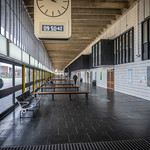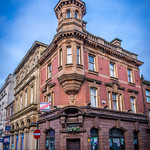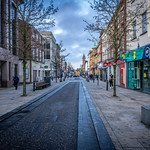- Preston City Council local elections 2024 candidates list set out
- Blog Preston reaches crowdfunding goal for expanded arts and culture coverage
- Harris Institute owners move to squash ‘for sale’ rumours
- “Unacceptable” and “must do better” as Preston records highest rough sleeper count since records began
- Preston Animate cinema reaches highest point in construction
Brief History of Preston

The statue outside the old Corn Exchange in memory of four cotton workers shot down by troops after the Riot Act was read on Saturday 13th August 1842. Picture credit: Tony Worrall
To understand Preston you need to understand its past, here is a brief overview of the city’s history.
Preston was given its first charter in 1179, it was then a market town of around 1,500 people.
Around the middle of the 13th century Franciscan friars arrived in the city, but in 1539 Henry VII closed the Preston friary.
Battles were fought in and around the city during the English Civil War and in 1643 the Parliamentary troops – under Oliver Cromwell – capture Preston. It was quickly recaptured by the Royalists but they were forced to withdraw.
In 1680 the city has grown to 3,000 people and in 1699 it becomes lit by oil lamps.
Preston has always had strong links with Scotland but in 1715 a Jacobite army enters Preston, the town is surrounded by English troops and the Scots surrender. 12 people are executed for treason.
1771 and the first cotton mill opens in Preston. The industrial side of the city begins to take off as in 1792 the canal between Lancaster and Preston is built.
The population explodes in Preston to 11,887 making it a large town and one of the fastest growing in England.
The streets of Preston become lit by gas in 1816 and in 1838 the railway first reaches the town.
Between 1864 and 1900 the city experiences rapid growth, Miller Park is laid out, a new town hall is built along with a cattle market. In 1867 Moor Park opens, followed three years later by Preston Royal Infirmary.
Horse drawn trams appear in 1879 and 1881 sees the first telephone exchange open.
A crucial part of Preston’s history the Albert Edward Dock opens in 1892 and the Harris Museum follows a year later.
By 1901 the population reaches 120,000 but in the early 1920s the cotton industry in Preston collapses. In 1939 a large rayon factory opens and the town is involved in the war effort.
The modern face of Preston begins to appear from the 1950s as immigrants from India, Pakistan and the West Indies settle in Preston. In 1958 the Preston by-pass is built. Preston becomes a city in 2002.
History resources and useful links:
A brief history of Preston by Tim Lambert
A timeline of Preston’s history by Tim Lambert
BBC: The history of Preston by Melvyn Dod
Made in Preston’s history of Preston
Wikipedia: History of Preston
History of Preston Dock
UCLan: A potted history of Preston
Preston Historical Society
If you’ve got a website or page related to the history of Preston, please email us with the details to contactus@blogpreston.co.uk
Preston History Quiz
You can also try out your knowledge of Preston with our Preston History Quiz, just click on the map below for where the landmarks are and try to beat the top score:











 Advertisement
Advertisement